New Insights into Crust and upper Mantle Structure in Guangdong Province, China and Its Geothermal Implications
Abstract
:1. Introduction
2. Geological Setting
3. MT Data Acquisition
4. MT Data Analysis, Inversion, and Result
4.1. MT Data Analysis
4.2. MT Data Inversion
4.3. Inversion Results
5. Interpretations and Discussions
5.1. Interpretations of the Model
5.2. Lithosphere and Asthenosphere
5.2.1. Thickness of Lithosphere and Structure of the upper Mantle
5.2.2. Structure of the Crust
5.3. Interpretation of the Geothermal Anomalies in Guangdong Province
6. Conclusions
- Three new MT profiles with a total of 440 km long across the major portion of Guangdong Province were acquired to reconstruct crust and upper mantle structure. The TM model of the nonlinear conjugate gradient (NLCG) two-dimensional inversion with τ = 3 was determined by data analysis;
- Inversion results show that the low resistance zone on the shallow surface matches the actual location of the fault; there is the presence of multi upwelling channels of asthenosphere mantle, and some channels are connected with shallow crustal fault zone; the thickness of the crust and the lithosphere in Guangdong Province are relatively thin. The crust and upper mantle structure in Guangdong Province is the result of long-term (from Proterozoic to Cenozoic) tectonic magmatism, especially the intense tectonic magmatism caused by multi-plate interaction since the late Mesozoic. Such special crust and upper mantle structure forms high surface heat flow and is one of the key factors for generating anomalies;
- Massive Late Mesozoic granites, which contain high radioactive heat-producing elements, are distributed on the surface and underground of Guangdong Province. Large quantities of heat released from persistent radioactive decay of Late Mesozoic granite are another significant geothermal mechanism in Guangdong Province.
Supplementary Materials
Author Contributions
Funding
Acknowledgments
Conflicts of Interest
References
- Zheng, Y.-F.; Xiao, W.-J.; Zhao, G. Introduction to tectonics of China. Gondwana Res. 2013, 23, 1189–1206. [Google Scholar] [CrossRef]
- Suo, Y.; Li, S.; Jin, C.; Zhang, Y.; Zhou, J.; Li, X.; Wang, P.; Liu, Z.; Wang, X.; Somerville, I. Eastward tectonic migration and transition of the Jurassic-Cretaceous Andean-type continental margin along Southeast China. Earth Sci. Rev. 2019, 196, 102884. [Google Scholar] [CrossRef]
- Kuang, J.; Wang, S.; Qi, S.; Xiao, Z.; Zhang, M.; Wang, Y. Cenozoic tectonic evolution of South China: A brief review, and new insights from the Huangshadong-Shiba area, south-east China. Geol. J. 2020, 55, 7716–7737. [Google Scholar] [CrossRef]
- Zhou, X.; Sun, T.; Shen, W.; Shu, L.; Niu, Y. Petrogenesis of Mesozoic granitoids and volcanic rocks in South China: A response to tectonic evolution. Episodes 2006, 29, 26. [Google Scholar] [CrossRef] [PubMed] [Green Version]
- Li, Z.-X.; Li, X.-H. Formation of the 1300-km-wide intracontinental orogen and postorogenic magmatic province in Mesozoic South China: A flat-slab subduction model. Geology 2007, 35, 179–182. [Google Scholar] [CrossRef]
- Wang, Y.; Fan, W.; Zhang, G.; Zhang, Y. Phanerozoic tectonics of the South China Block: Key observations and controversies. Gondwana Res. 2013, 23, 1273–1305. [Google Scholar] [CrossRef]
- Xu, X.; O’Reilly, S.Y.; Griffin, W.L.; Wang, X.; Pearson, N.J.; He, Z. The crust of Cathaysia: Age, assembly and reworking of two terranes. Precambr. Res. 2007, 158, 51–78. [Google Scholar] [CrossRef]
- Zhou, Z.-M.; Ma, C.-Q.; Qi, S.-H.; Xi, Y.-F.; Liu, W. Late Mesozoic high-heat-producing (HHP) and high-temperature geothermal reservoir granitoids: The most significant geothermal mechanism in South China. Lithos 2020, 366, 105568. [Google Scholar] [CrossRef]
- Zhou, L.; Xie, J.; Shen, W.; Zheng, Y.; Yang, Y.; Shi, H.; Ritzwoller, M.H. The structure of the crust and uppermost mantle beneath South China from ambient noise and earthquake tomography. Geophys. J. Int. 2012, 189, 1565–1583. [Google Scholar] [CrossRef] [Green Version]
- Shan, B.; Afonso, J.C.; Yang, Y.; Grose, C.J.; Zheng, Y.; Xiong, X.; Zhou, L. The thermochemical structure of the lithosphere and upper mantle beneath south China: Results from multiobservable probabilistic inversion. J. Geophys. Res. Solid Earth 2014, 119, 8417–8441. [Google Scholar] [CrossRef] [Green Version]
- Zheng, T.-Y.; Zhao, L.; He, Y.-M.; Zhu, R.-X. Seismic imaging of crustal reworking and lithospheric modification in eastern China. Geophys. J. Int. 2014, 196, 656–670. [Google Scholar] [CrossRef] [Green Version]
- Deng, Y.; Levandowski, W. Lithospheric Alteration, Intraplate Crustal Deformation, and Topography in Eastern China. Tectonics 2018, 37, 4120–4134. [Google Scholar] [CrossRef]
- Zhang, H.-F.; Sun, M.; Lu, F.-X.; Zhou, X.-H.; Zhou, M.-F.; Liu, Y.-S.; Zhang, G.-H. Geochemical significance of a garnet lherzolite from the Dahongshan kimberlite, Yangtze Craton, southern China. Geochem. J. 2001, 35, 315–331. [Google Scholar] [CrossRef]
- Liu, C.-Z.; Liu, Z.-C.; Wu, F.-Y.; Chu, Z.-Y. Mesozoic accretion of juvenile sub-continental lithospheric mantle beneath South China and its implications: Geochemical and Re–Os isotopic results from Ningyuan mantle xenoliths. Chem. Geol. 2012, 291, 186–198. [Google Scholar] [CrossRef]
- Zheng, J.P.; Lee, C.-T.A.; Lu, J.G.; Zhao, J.H.; Wu, Y.B.; Xia, B.; Li, X.Y.; Zhang, J.F.; Liu, Y.S. Refertilization-driven destabilization of subcontinental mantle and the importance of initial lithospheric thickness for the fate of continents. Earth Planet. Sci. Lett. 2015, 409, 225–231. [Google Scholar] [CrossRef]
- Hu, S.; He, L.; Wang, J. Heat flow in the continental area of China: A new data set. Earth Planet. Sci. Lett. 2000, 179, 407–419. [Google Scholar] [CrossRef]
- Jiang, G.; Hu, S.; Shi, Y.; Zhang, C.; Wang, Z.; Hu, D. Terrestrial heat flow of continental China: Updated dataset and tectonic implications. Tectonophysics 2019, 753, 36–48. [Google Scholar] [CrossRef]
- Xi, Y.; Wang, G.; Liu, S.; Zhao, Y.; Hu, X. The formation of a geothermal anomaly and extensional structures in Guangdong, China: Evidence from gravity analyses. Geothermics 2018, 72, 225–231. [Google Scholar] [CrossRef]
- Van der Zwaan, B.; Dalla Longa, F. Integrated assessment projections for global geothermal energy use. Geothermics 2019, 82, 203–211. [Google Scholar] [CrossRef]
- Ceglia, F.; Macaluso, A.; Marrasso, E.; Roselli, C.; Vanoli, L. Energy, Environmental, and Economic Analyses of Geothermal Polygeneration System Using Dynamic Simulations. Energies 2020, 13, 4603. [Google Scholar] [CrossRef]
- Ceglia, F.; Macaluso, A.; Marrasso, E.; Sasso, M.; Vanoli, L. Modelling of Polymeric Shell and Tube Heat Exchangers for Low-Medium Temperature Geothermal Applications. Energies 2020, 13, 2737. [Google Scholar] [CrossRef]
- Tao, N.; Li, Z.-X.; Danišík, M.; Evans, N.J.; Batt, G.E.; Li, W.-X.; Pang, C.-J.; Jourdan, F.; Xu, Y.-G.; Liu, L.-P. Thermochronological record of Middle–Late Jurassic magmatic reheating to Eocene rift-related rapid cooling in the SE South China Block. Gondwana Res. 2017, 46, 191–203. [Google Scholar] [CrossRef]
- Ren, J.; Tamaki, K.; Li, S.; Junxia, Z. Late Mesozoic and Cenozoic rifting and its dynamic setting in Eastern China and adjacent areas. Tectonophysics 2002, 344, 175–205. [Google Scholar] [CrossRef]
- Gong, J.; Chen, Y.J. Evidence of lateral asthenosphere flow beneath the South China craton driven by both Pacific plate subduction and the India–Eurasia continental collision. Terra Nova 2014, 26, 55–63. [Google Scholar] [CrossRef]
- Gamble, T.D.; Goubau, W.M.; Clarke, J. Magnetotellurics with a remote magnetic reference. Geophysics 1979, 44, 53–68. [Google Scholar] [CrossRef] [Green Version]
- Egbert, G.D.; Booker, J.R. Robust estimation of geomagnetic transfer functions. Geophys. J. R. Astron. Soc. 1986, 87, 173–194. [Google Scholar] [CrossRef] [Green Version]
- Groom, R.W.; Bailey, R.C. Decomposition of magnetotelluric impedance tensors in the presence of local three-dimensional galvanic distortion. J. Geophys. Res. Solid Earth 1989, 94, 1913–1925. [Google Scholar] [CrossRef] [Green Version]
- Rodi, W.; Mackie, R.L. Nonlinear conjugate gradients algorithm for 2-D magnetotelluric inversion. Geophysics 2001, 66, 174–187. [Google Scholar] [CrossRef]
- Berdichevsky, M.N. Marginal Notes on Magnetotellurics. Surv. Geophys. 1999, 20, 341–375. [Google Scholar] [CrossRef]
- Ledo, J. 2-D versus 3-D magnetotelluric data interpretation. Surv. Geophys. 2005, 26, 511–543. [Google Scholar] [CrossRef]
- Zhang, M.; Guo, Z.; Liu, J.; Liu, G.; Zhang, L.; Lei, M.; Zhao, W.; Ma, L.; Sepe, V.; Ventura, G. The intraplate Changbaishan volcanic field (China/North Korea): A review on eruptive history, magma genesis, geodynamic significance, recent dynamics and potential hazards. Earth Sci. Rev. 2018, 187, 19–52. [Google Scholar] [CrossRef]
- Zhao, L.; Allen, R.M.; Zheng, T.; Zhu, R. High-resolution body wave tomography models of the upper mantle beneath eastern China and the adjacent areas. Geochem. Geophys. Geosyst. 2012, 13. [Google Scholar] [CrossRef] [Green Version]
- Hu, X.Y.; Bi, B.T.; Liu, G.X.; Han, J.T.; Cai, J.C.; Peng, R.H.; Xu, S.; Liu, S.J. The lithospheric electrical structure of ji’an-fuzhou profile in the east part of south china. Chin. J. Geophys. 2017, 60, 532–543. [Google Scholar]
- Menke, W.; Lamoureux, J.; Abbott, D.; Hopper, E.; Hutson, D.; Marrero, A. Crustal heating and lithospheric alteration and erosion associated with asthenospheric upwelling beneath southern New England (USA). J. Geophys. Res. Solid Earth 2018, 123, 8995–9008. [Google Scholar] [CrossRef]
- Zheng, Y.; Xu, Z.; Zhao, Z.; Dai, L. Mesozoic mafic magmatism in North China: Implications for thinning and destruction of cratonic lithosphere. Sci. China Earth Sci. 2018, 61, 353–385. [Google Scholar] [CrossRef]
- Yu, J.-H.; Wei, Z.-Y.; Wang, L.-J.; Shu, L.-S.; Sun, T. Cathaysia Block: A young continent composed of ancient materials. Geol. J. China Univ. 2006, 12, 440–447. [Google Scholar]
- Ai, Y.; Zheng, T. The upper mantle discontinuity structure beneath eastern China. Geophys. Res. Lett. 2003, 30. [Google Scholar] [CrossRef] [Green Version]
- Chen, L.; Ai, Y. Discontinuity structure of the mantle transition zone beneath the North China Craton from receiver function migration. J. Geophys. Res. Solid Earth 2009, 114. [Google Scholar] [CrossRef]
- Xu, W.; Zheng, T.; Zhao, L. Mantle dynamics of the reactivating North China Craton: Constraints from the topographies of the 410-km and 660-km discontinuities. Sci. China Earth Sci. 2011, 54, 881–887. [Google Scholar] [CrossRef]
- Huang, J.; Zhao, D. High-resolution mantle tomography of China and surrounding regions. J. Geophys. Res. Solid Earth 2006, 111. [Google Scholar] [CrossRef]
- Li, C.; Hilst, R.D. Structure of the upper mantle and transition zone beneath Southeast Asia from traveltime tomography. J. Geophys. Res. Solid Earth 2010, 115. [Google Scholar] [CrossRef]
- Zhao, D.; Maruyama, S.; Omori, S. Mantle dynamics of Western Pacific and East Asia: Insight from seismic tomography and mineral physics. Gondwana Res. 2007, 11, 120–131. [Google Scholar] [CrossRef]
- Yan, D.; Tian, Y.; Zhao, D.; Liu, C.; Zhu, H.; Li, H. Upper mantle temperature structure of the North China Craton. Phys. Earth Planet. Inter. 2019, 293, 106269. [Google Scholar] [CrossRef]
- Lallemand, S.; Theunissen, T.; Schnürle, P.; Lee, C.-S.; Liu, C.-S.; Font, Y. Indentation of the Philippine Sea plate by the Eurasia plate in Taiwan: Details from recent marine seismological experiments. Tectonophysics 2013, 594, 60–79. [Google Scholar] [CrossRef] [Green Version]
- Wu, J.; Suppe, J.; Lu, R.; Kanda, R. Philippine Sea and East Asian plate tectonics since 52 Ma constrained by new subducted slab reconstruction methods. J. Geophys. Res. Solid Earth 2016, 121, 4670–4741. [Google Scholar] [CrossRef] [Green Version]
- Ye, Q.; Mei, L.; Shi, H.; Camanni, G.; Shu, Y.; Wu, J.; Yu, L.; Deng, P.; Li, G. The Late Cretaceous tectonic evolution of the South China Sea area: An overview, and new perspectives from 3D seismic reflection data. Earth Sci. Rev. 2018, 187, 186–204. [Google Scholar] [CrossRef]
- Ye, Q.; Mei, L.; Shi, H.; Shu, Y.; Camanni, G.; Wu, J. A low-angle normal fault and basement structures within the Enping Sag, Pearl River Mouth Basin: Insights into late Mesozoic to early Cenozoic tectonic evolution of the South China Sea area. Tectonophysics 2018, 731, 1–16. [Google Scholar] [CrossRef]
- Raddick, M.J.; Parmentier, E.M.; Scheirer, D.S. Buoyant decompression melting: A possible mechanism for intraplate volcanism. J. Geophys. Res. Solid Earth 2002, 107, ECV 7-1–ECV 7-14. [Google Scholar] [CrossRef]
- Zou, H.; Fan, Q.; Yao, Y. U–Th systematics of dispersed young volcanoes in NE China: Asthenosphere upwelling caused by piling up and upward thickening of stagnant Pacific slab. Chem. Geol. 2008, 255, 134–142. [Google Scholar] [CrossRef]
- Sakuyama, T.; Tian, W.; Kimura, J.-I.; Fukao, Y.; Hirahara, Y.; Takahashi, T.; Senda, R.; Chang, Q.; Miyazaki, T.; Obayashi, M.; et al. Melting of dehydrated oceanic crust from the stagnant slab and of the hydrated mantle transition zone: Constraints from Cenozoic alkaline basalts in eastern China. Chem. Geol. 2013, 359, 32–48. [Google Scholar] [CrossRef]
- Huang, J.; Li, S.-G.; Xiao, Y.; Ke, S.; Li, W.-Y.; Tian, Y. Origin of low δ26Mg Cenozoic basalts from South China Block and their geodynamic implications. Geochim. Cosmochim. Acta 2015, 164, 298–317. [Google Scholar] [CrossRef]
- Liu, C.-Z.; Wu, F.-Y.; Sun, J.; Chu, Z.-Y.; Qiu, Z.-L. The Xinchang peridotite xenoliths reveal mantle replacement and accretion in southeastern China. Lithos 2012, 150, 171–187. [Google Scholar] [CrossRef]
- Zhang, Z.; Wang, Y. Crustal structure and contact relationship revealed from deep seismic sounding data in South China. Phys. Earth Planet. Inter. 2007, 165, 114–126. [Google Scholar] [CrossRef] [Green Version]
- Song, P.; Zhang, X.; Liu, Y.; Teng, J. Moho imaging based on receiver function analysis with teleseismic wavefield reconstruction: Application to South China. Tectonophysics 2017, 718, 118–131. [Google Scholar] [CrossRef]
- Zhang, J.; Wang, B.; Tang, X.; Dong, M.; Ai, Y. Temperature structure and dynamic background of crust and mantle beneath the high heat flow area of the South China continental margin (in Chinese with English abstract). Chin. J. Geophys. 2018, 61, 16. [Google Scholar]
- Deng, Y.; Li, J.; Peng, T.; Ma, Q.; Song, X.; Sun, X.; Shen, Y.; Fan, W. Lithospheric structure in the Cathaysia block (South China) and its implication for the Late Mesozoic magmatism. Phys. Earth Planet. Inter. 2019, 291, 24–34. [Google Scholar] [CrossRef]
- Davies, J.H. Global map of solid Earth surface heat flow. Geochem. Geophys. Geosyst. 2013, 14, 4608–4622. [Google Scholar] [CrossRef]
- Furlong, K.P.; Chapman, D.S. Heat Flow, Heat Generation, and the Thermal State of the Lithosphere. Annu. Rev. Earth Planet. Sci. 2013, 41, 385–410. [Google Scholar] [CrossRef]
- Hu, S.-B.; He, L.-J.; Wang, J.-Y. Compilation of Heat Flow Data in the China Continental Area. Chin. J. Geophys. 2001, 44, 604–618. [Google Scholar] [CrossRef]
- Li, X.-H.; Li, Z.-X.; Li, W.-X.; Liu, Y.; Yuan, C.; Wei, G.; Qi, C. U–Pb zircon, geochemical and Sr–Nd–Hf isotopic constraints on age and origin of Jurassic I- and A-type granites from central Guangdong, SE China: A major igneous event in response to foundering of a subducted flat-slab? Lithos 2007, 96, 186–204. [Google Scholar] [CrossRef]
- Xiao, Z.; Wang, S.; Qi, S.; Kuang, J.; Zhang, M.; Tian, F.; Han, Y. Petrogenesis, Tectonic Evolution and Geothermal Implications of Mesozoic Granites in the Huangshadong Geothermal Field, South China. J. Earth Sci. 2020, 31, 141–158. [Google Scholar] [CrossRef]
- Sun, Z.; Wang, A.; Liu, J.; Hu, B.; Chen, G. Radiogenic heat production of granites and potential for hot dry rock geothermal resource in Guangdong Province, Southern China. In Proceedings of the World Geothermal Congress, Melbourne, Australia, 19–25 April 2015; pp. 2–6. [Google Scholar]
- Wang, S.; Kuang, J.; Huang, X.; Zhang, H.; Zhang, M.; Qi, S.; Han, Y.; Xiao, Z.; Wang, S.; Tang, L. Upwelling of Mantle Derived Material in Southeast China: Evidence from Noble Gas Isotopes. Acta Geol. Sin. Engl. Ed. 2021. [Google Scholar] [CrossRef]

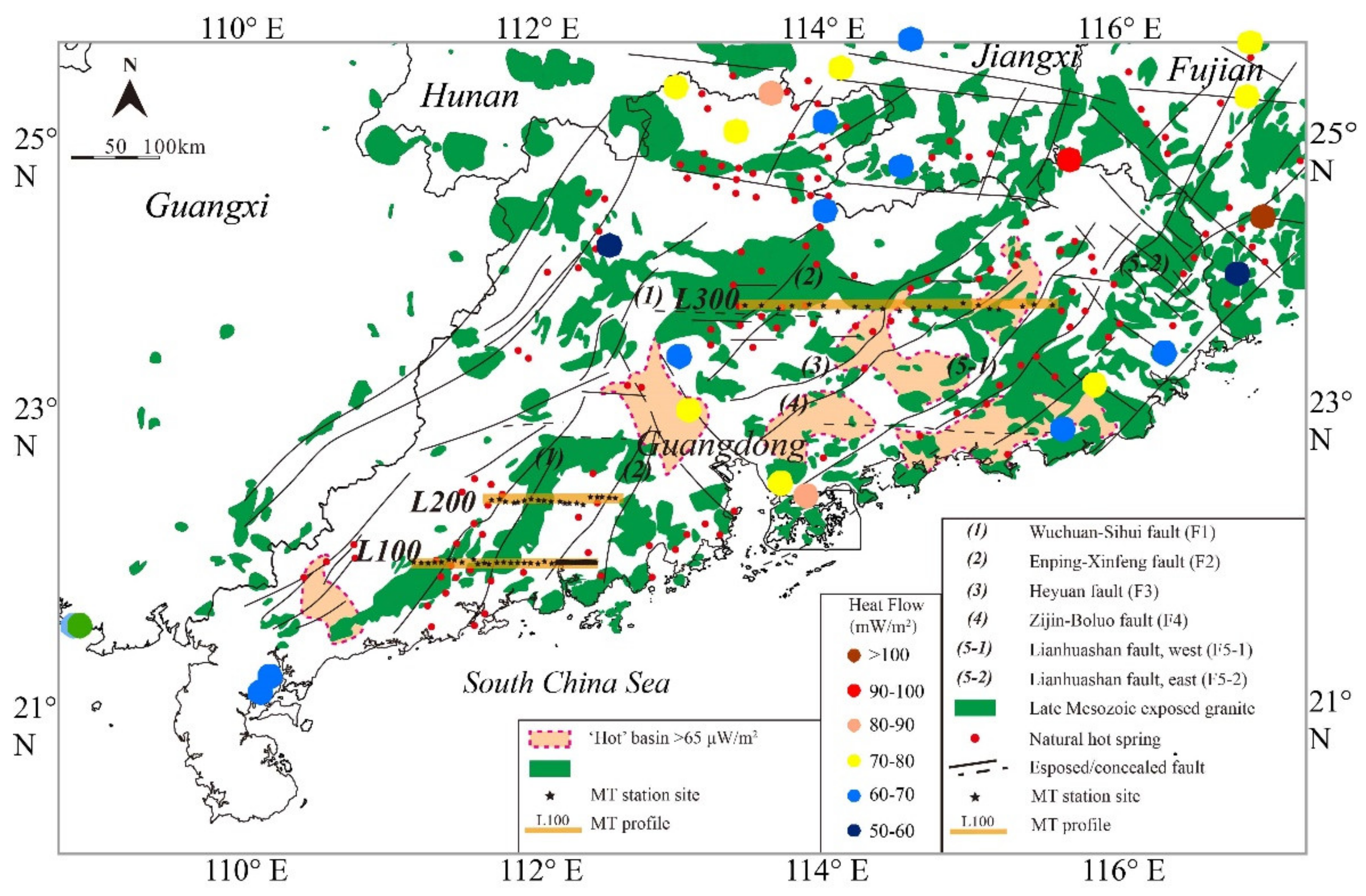

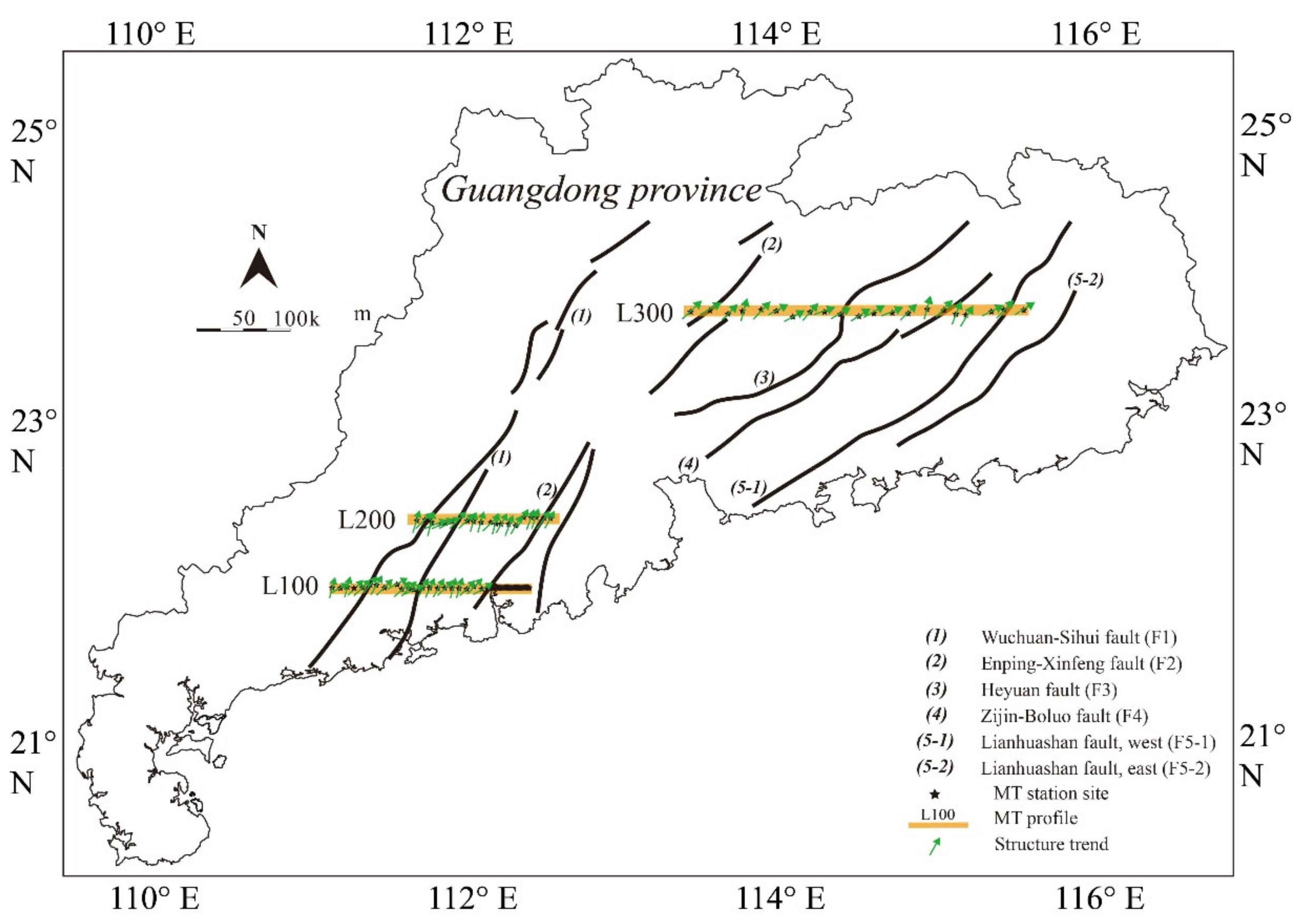
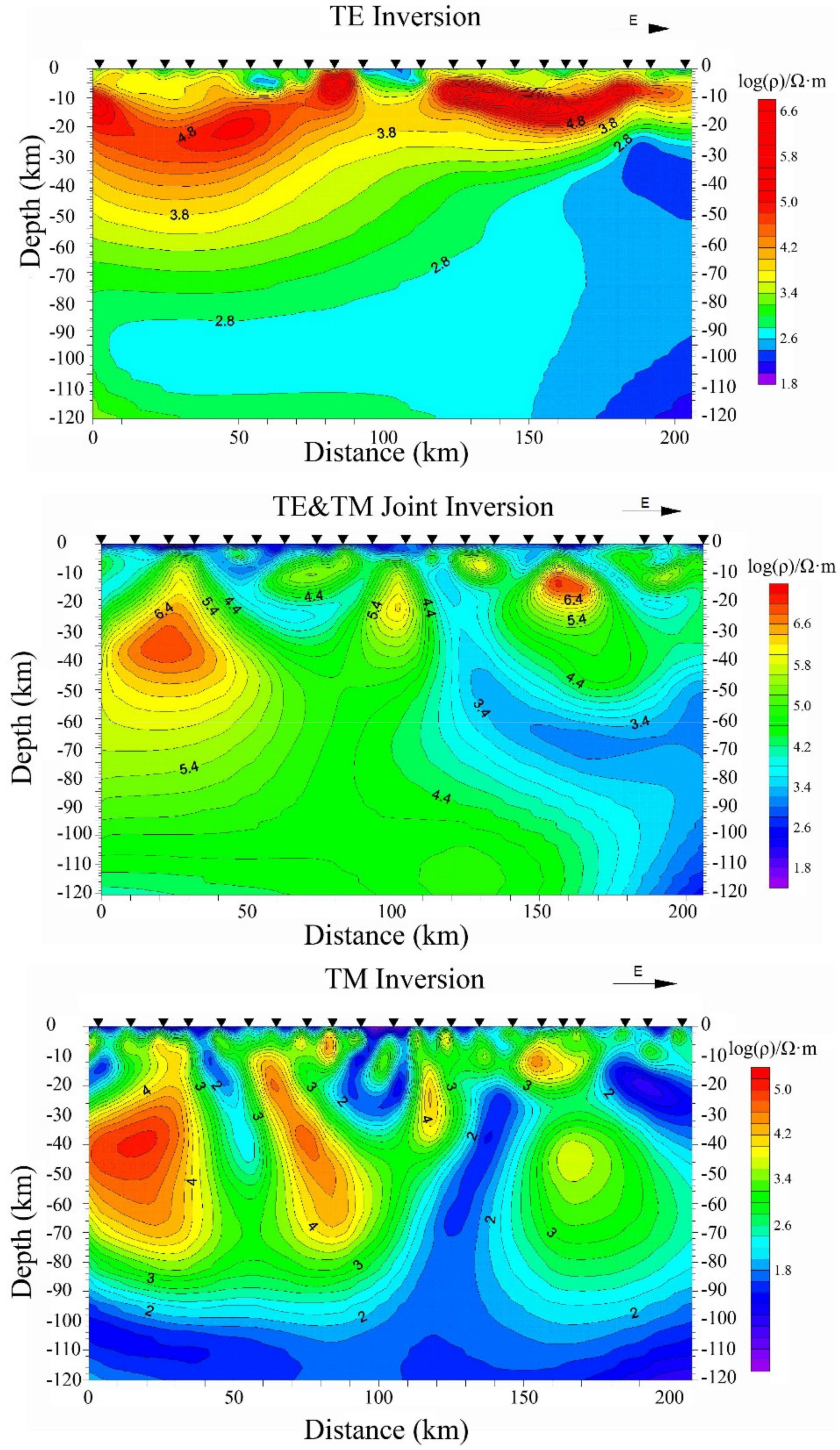


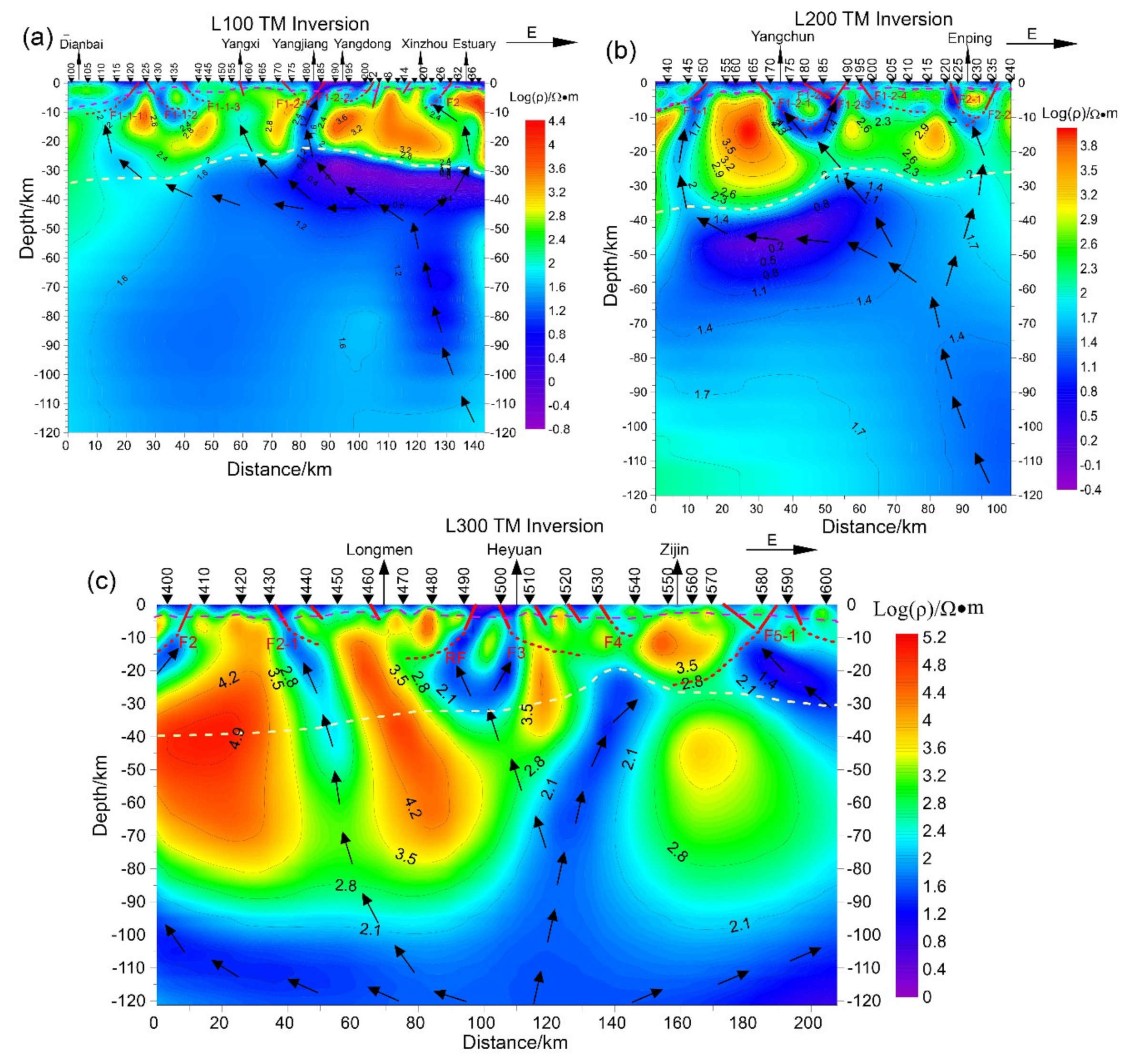
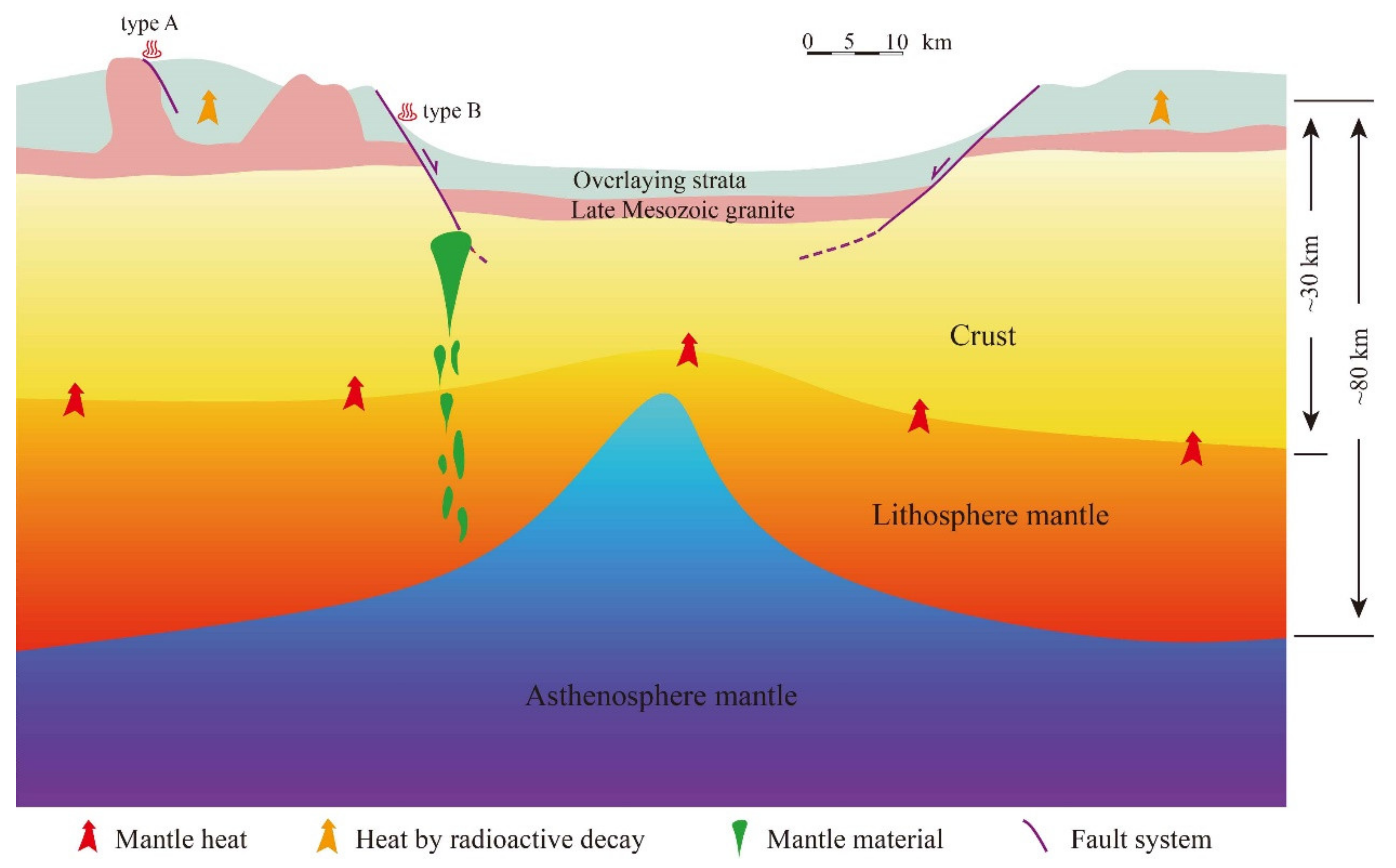
Publisher’s Note: MDPI stays neutral with regard to jurisdictional claims in published maps and institutional affiliations. |
© 2021 by the authors. Licensee MDPI, Basel, Switzerland. This article is an open access article distributed under the terms and conditions of the Creative Commons Attribution (CC BY) license (https://creativecommons.org/licenses/by/4.0/).
Share and Cite
Kuang, J.; Qi, S.; Hu, X. New Insights into Crust and upper Mantle Structure in Guangdong Province, China and Its Geothermal Implications. Energies 2021, 14, 2236. https://doi.org/10.3390/en14082236
Kuang J, Qi S, Hu X. New Insights into Crust and upper Mantle Structure in Guangdong Province, China and Its Geothermal Implications. Energies. 2021; 14(8):2236. https://doi.org/10.3390/en14082236
Chicago/Turabian StyleKuang, Jian, Shihua Qi, and Xiangyun Hu. 2021. "New Insights into Crust and upper Mantle Structure in Guangdong Province, China and Its Geothermal Implications" Energies 14, no. 8: 2236. https://doi.org/10.3390/en14082236





